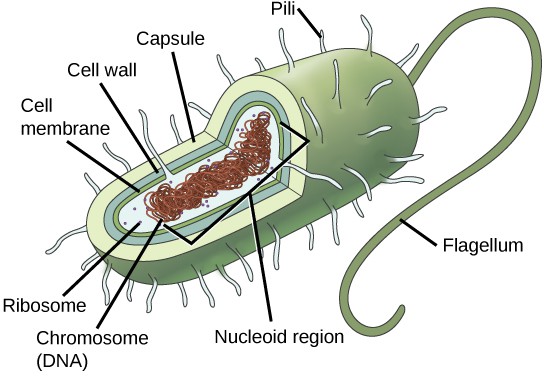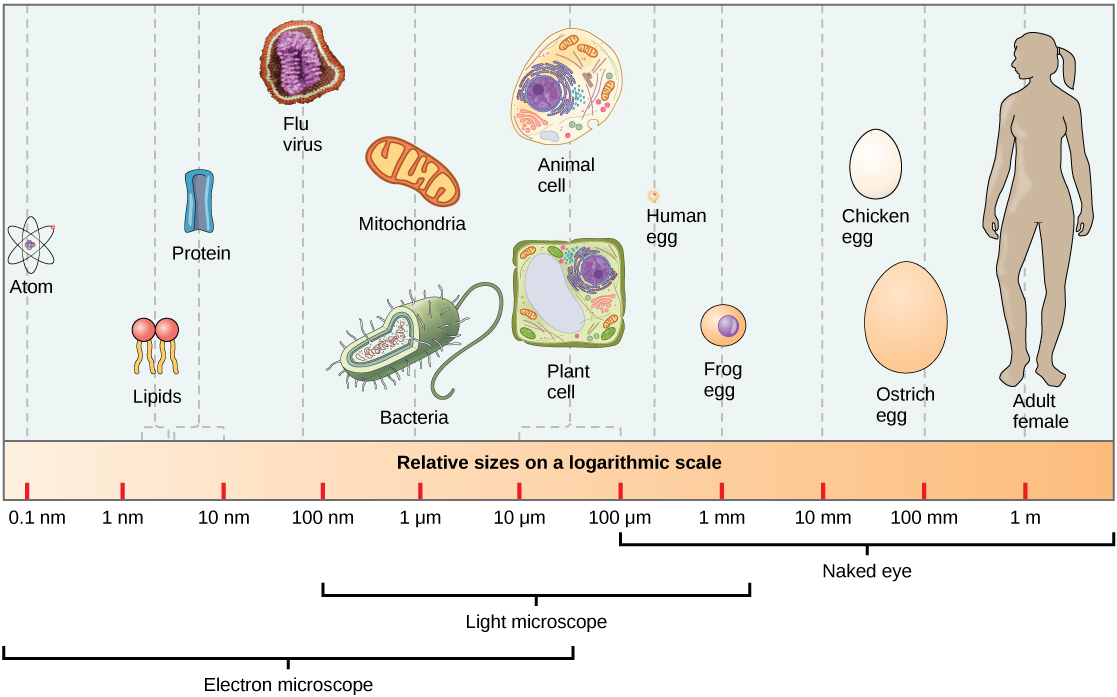Comparing Prokaryotes and Eukaryotes
Section Goals
By the end of this section, you will be able to do the following:
- Describe the role of cells in organisms
- Identify features common to all cells
- Compare and contrast prokaryotic and eukaryotic cells
Close your eyes and picture a brick wall. What is the wall’s basic building block? It is a single brick. Like a brick wall, cells are the building blocks that make up your body.
Your body has many kinds of cells, each specialized for a specific purpose. Just as we use a variety of materials to build a home, the human body is constructed from many cell types. For example, epithelial cells protect the body’s surface and cover the organs and body cavities within. Bone cells help to support and protect the body. Immune system cells fight invading bacteria. Additionally, blood and blood cells carry nutrients and oxygen throughout the body while removing carbon dioxide. Each of these cell types plays a vital role during the body’s growth, development, and day-to-day maintenance. In spite of their enormous variety, however, cells from all organisms—even ones as diverse as bacteria, onions, and humans—share certain fundamental characteristics.
There are two types of cells: prokaryotic and eukaryotic. In this section, we’ll explore the similarities and differences between these two types.
Comparing Prokaryotic and Eukaryotic Cells
The cell theory states that one or more cells comprise all living things, that the cell is the basic unit of life, and that new cells arise from existing cells. A cell is the smallest unit of a living thing. Whether composed of one cell (like bacteria) or many cells (like a human), we call it an organism. Thus, cells are the basic building blocks of all organisms.
Several cells of one kind interconnect with each other and perform a shared function to form tissues. These tissues combine to form an organ (your stomach, heart, or brain), and several organs comprise an organ system (such as the digestive system, circulatory system, or nervous system). Several systems that function together form an organism (like a human being). Here, we will examine the structure and function of cells.
There are many types of cells, which scientists group into one of two broad categories: prokaryotic and eukaryotic. The single-celled organisms of the domains Bacteria and Archaea are classified as prokaryotes (pro = before; karyon– = nucleus). Animal cells, plant cells, fungi, and protists are eukaryotes (eu = true).
Components of Prokaryotic Cells
All cells share four common components: (1) a plasma membrane, an outer covering that separates the cell’s interior from its surrounding environment; (2) cytoplasm, consisting of a jelly-like region within the cell in which other cellular components are found; (3) DNA, the genetic material of the cell; and (4) ribosomes, particles that synthesize proteins. However, prokaryotes differ from eukaryotic cells in several ways.

A prokaryotic cell is a simple, single-celled (unicellular) organism that lacks a nucleus or any other membrane-bound organelle. We will shortly come to see that this is significantly different in eukaryotes. Prokaryotic DNA is found in the central part of the cell: a darkened region called the nucleoid (Figure 1).
Unlike Archaea and eukaryotes, bacteria have a cell wall made of peptidoglycan, composed of sugars and amino acids, and many have a polysaccharide capsule (Figure 1). The cell wall acts as an extra layer of protection, helps the cell maintain its shape, and prevents dehydration. The capsule enables the cell to attach to surfaces in its environment. Some prokaryotes have flagella, pili, or fimbriae. Flagella are used for locomotion, while most pili are used to exchange genetic material during a type of reproduction called conjugation.
Eukaryotic Cells
In nature, the relationship between form and function is apparent at all levels, including the level of the cell, and this will become clear as we explore eukaryotic cells. The principle “form follows function” is found in many contexts. It means that, in general, one can deduce the function of a structure by looking at its form because the two are matched. For example, birds and fish have streamlined bodies that allow them to move quickly through the medium in which they live, be it air or water.
A eukaryotic cell is a cell that has a membrane-bound nucleus and other membrane-bound compartments or sacs, called organelles, which have specialized functions. The word eukaryotic means “true nucleus,” alluding to the presence of the membrane-bound nucleus in these cells. The word “organelle” means “little organ,” and, as we learned earlier, organelles have specialized cellular functions, just as the organs of your body have specialized functions.
Data from fossils, as well as from the study of living genomes, have led comparative biologists to conclude that living eukaryotes are all descendants of a single common ancestor. Mapping the characteristics found in all major groups of eukaryotes reveals that the following characteristics are present in at least some of the members of each major lineage or during some part of their life cycle and, therefore must have been present in the last common ancestor.
- Cells with nuclei surrounded by a nuclear envelope with nuclear pores: This is the single characteristic that is both necessary and sufficient to define an organism as a eukaryote. All extant eukaryotes have cells with nuclei.
- Mitochondria: Most extant eukaryotes have “typical” mitochondria, although some eukaryotes have very reduced mitochondrial “remnants” and a few lack detectable mitochondria.
- Cytoskeleton of microtubules and microfilaments: Eukaryotic cells possess the structural and motility components called actin microfilaments and microtubules. All extant eukaryotes have these cytoskeletal elements.
- Flagella and cilia: Organelles associated with cell motility. Some extant eukaryotes lack flagella and/or cilia, but their presence in related lineages suggests that they are descended from ancestors that possessed these organelles.
- Chromosomes organized by histones: Each eukaryotic chromosome consists of a linear DNA molecule coiled around basic (alkaline) proteins called histones. The few eukaryotes with chromosomes lacking histones clearly evolved from ancestors that had them.
- Mitosis: A process of nuclear division in which replicated chromosomes are divided and Separated using elements of the cytoskeleton. Mitosis is universally present in eukaryotes.
- Sexual reproduction: A meiotic process of nuclear division and genetic recombination unique to eukaryotes. During this process, diploid nuclei at one stage of the life cycle undergo meiosis to yield haploid nuclei, which subsequently fuse together (karyogamy) to create a diploid zygote nucleus.
- Cell walls: It is reasonable to conclude that the last common ancestor could make cell walls during some stage of its life cycle because cell walls were present in their prokaryote precursors. However, not enough is known about eukaryotes’ cell walls and their development to know how much homology exists between those of prokaryotes and eukaryotes. If the last common ancestor could make cell walls, it is clear that this ability must have been lost in many groups.
Cell Size
At 0.1–5.0 µm in diameter, prokaryotic cells are significantly smaller than eukaryotic cells, which have diameters ranging from 10–100 µm (Figure 2). The small size of prokaryotes allows ions and organic molecules that enter them to quickly spread to other parts of the cell. Similarly, any waste produced within a prokaryotic cell can quickly move out. However, larger eukaryotic cells have evolved different structural adaptations to enhance cellular transport. Indeed, the large size of these cells would not be possible without these adaptations. In general, cell size is limited because volume increases much more quickly than does cell surface area. As a cell becomes larger, it becomes more and more difficult for the cell to acquire sufficient materials to support the processes inside the cell, because the relative size of the surface area across which materials must be transported declines.

Did I Get It?
Summary: Comparing Prokaryotic And Eukaryotic Cells
CC Licensed Content, Shared Previously, Included in Introduction to the Organisms
- Biology 2e. Authors: Mary Ann Clark, Matthew Douglas and Jung Choi. Provided by: OpenStax CNX. Located at: Biology 2e. License: CC BY: Attribution 4.0.
- Biology for Majors II. Authors: Shelly Carter and Monisha Scott. Provided by: Lumen Learning. Located at: Biology for Majors II | Simple Book Production. License: CC BY: Attribution 4.0.
- Eukaryotic Origins* – Biology LibreTexts. Provided by: LibreTexts. Located at: Eukaryotic Origins* – Biology LibreTexts. License: Not declared.

